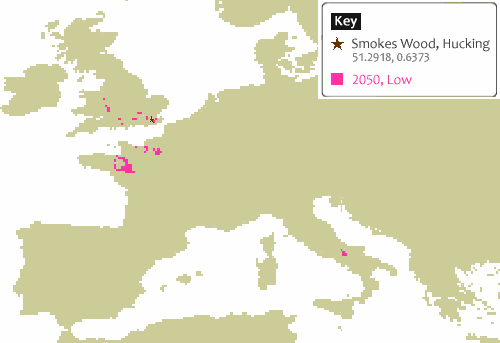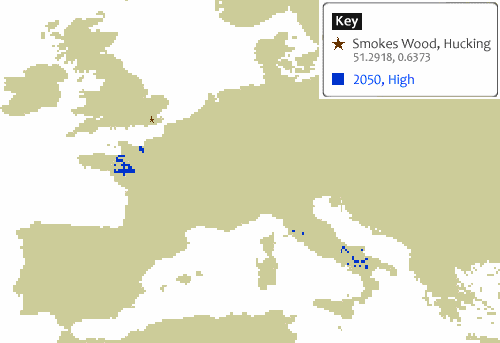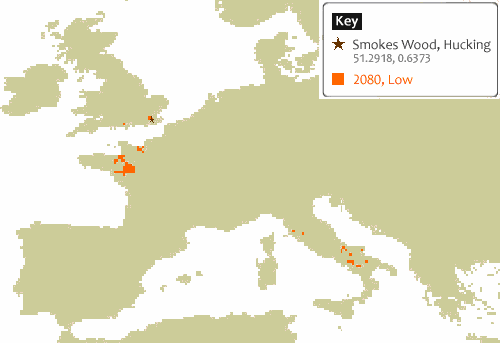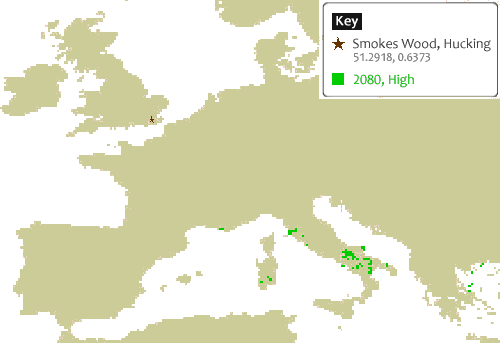Summary
Extending tree species choice
A warmer climate may provide conditions for a wider range of species that were considered not-reliably cold-hardy in the past. The table suggests species that could be considered. Species on the left have been trialled in plots across Britain, whereas those on the right have not been screened or trialled, although new trials are in preparation for some species.
Extending provenance choice
Results from a very limited number of European wide provenance trials suggest that material from 2 degrees of latitude south of a site should be better adapted to a warmer climate, and that by adding a wider range of provenance into woodlands an improvement in resilience to the effects of climate change will occur, and improved productivity might be achieved. Recent Advice suggests that in addition small amounts of provenance material from up to 5 degrees of latitude of a site may be mixed in woodlands.
Climate matching
It is possible to match the location of contemporary climate to those projected for a site in the future. Forest Research has a climate matching tool that can be used to show where species and provenance material might be sourced for sites in England.
Projected climatic conditions in Kent for 2050 and 2080 Low and High emissions scenarios:




Frost
Although the warmer climate may suit species and provenance from further south in Europe, it is important to remember the difference between winter cold and frost. There is a danger that the extended early and late growing season that will accompany a changing climate could potentially put trees at more risk of damage by frost. Therefore, it is always better to choose species that are less sensitive to frost on sites (flat, east or south facing) that are susceptible to frost.
Additional species to consider
Below is a list of tree species, presented in the Read Report, that might be suitable of particular sites.
Some additional tree species that might be considered in climate change adaptation strategies for production forestry in England.
| Species for which there is existing UK-based knowledge of performance from operational trials/ forest gardens/arboreta | Species for which there is little or no UK trials data, but where expert knowledge suggests that they merit screening for UK potential | |
|---|---|---|
| Conifers | Abies alba | Abies bornmuelleriana |
| Abies amabilis | Abies cephalonica | |
| Abies nordmanniana | Pinus armandii | |
| Cedrus atlantica | Pinus ayacahuite | |
| Cedrus libani | Pinus brutia | |
| Cryptomeria japonica | Pinus elliottii | |
| Picea omorika | Pinus koraiensis | |
| Picea orientalis | Pinus monticola | |
| Pinus peuce | Pinus strobus | |
| Pinus pinaster | Pinus taeda | |
| Sequoia sempervirens | Pinus wallichiana | |
| Thuja plicata | Pinus yunnanensis | |
| Broadleaves | Acer macrophyllum | Betula papyrifera |
| Acer saccharinum | Carya ovata | |
| Alnus rubra | Eucalyptus spp. | |
| Alnus viridis | Fagus orientalis | |
| Eucalyptus gunnii | Fraxinus americana | |
| Eucalyptus nitens | Fraxinus angustifolia | |
| Juglans regia | Fraxinus pennsylvanica | |
| Nothofagus obliqua | Juglans nigra | |
| Nothofagus alpina (syn. N. procera) | Liriodendron tulipifera | |
| Nothofagus pumilio | Quercus alba | |
| Platanus spp. | Quercus frainetto | |
| Populus spp. | Quercus pubescens | |
| Quercus pyrenaica |
